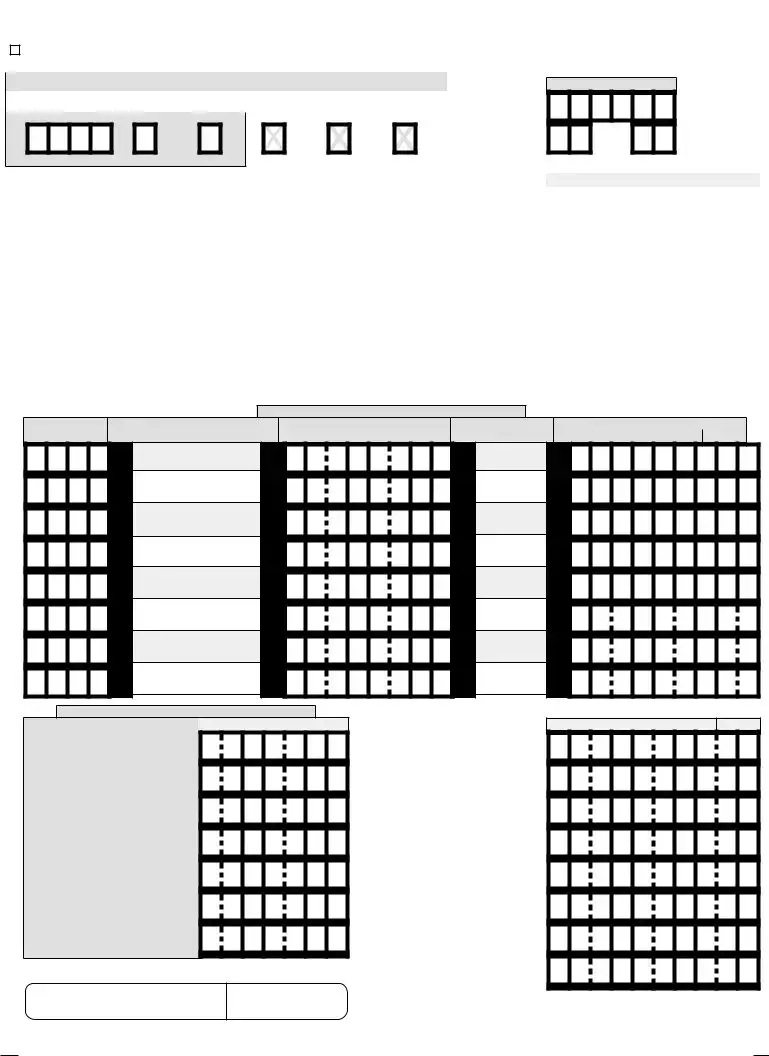GENERAL INSTRUCTIONS
Please use a #2 pencil or pen with black ink to make your entries on this form. If you type your report, please type "XXX" over "222" in box P. at the top of the form. If your mailing address or your business address has changed place an "X" in the proper Box F and enter the correct information in space provided below. If you are not required to file this form, call the Oklahoma Tax Commission at (405)521-3160.
|
SPECIFIC INSTRUCTIONS |
ITEM A. - |
Enter your taxpayer identification number. |
ITEM B. - |
Enter the month(s) and year for the sales being reported.(Begin with |
|
the month when you made your first sale) |
ITEM C. - |
Enter the date the report is due. |
ITEM D. - |
Enter your Sales Tax Permit Number. |
ITEM E. - |
Provide your name and mailing address. |
ITEM H. - |
Enter the total number of pages enclosed in the boxes to the right of |
|
the word "of." |
If you are closing your business and this will be your last sales tax return, mark over the "X" in block "G." and return your permit card with this report to the Oklahoma Tax Commission for cancellation.
LINE 1 (TOTAL SALES)- Enter the total amount of gross receipts of all sales, including taxable and non-taxable receipts, leases and rentals of tangible personal property. If no sales were made during the reporting period, leave blank.
LINE 2 (REMOVED FROM INVENTORY)- Enter the sales value of tangible personal property purchased for resale and consumed or used in this reporting period. Any merchandise purchased tax exempt with your sales tax permit and withdrawn for use by you or your business is to be included in this line. Also include amounts for purchases for which you are paying the sales tax directly to the Oklahoma Tax Commission.
LINE 3 (TOTAL SALES TAX EXEMPTIONS)- Use the Exemption Schedule, Item N, to compute the authorized exemptions from gross receipts for this reporting period. (Use Lines 3a. thru 3g.). Enter the amount of total sales tax exemptions on Line 3, at top.
3g. Explanation of 'Other Sales tax exemptions':
LINE 4 (NET TAXABLE SALES)- Subtract line 3 from the total of lines 1 and 2 to arrive at net taxable sales. If you have no amount subject to tax, leave blank.
LINE 5 (STATE TAX)- Multiply Line 4 by the applicable tax rate. If there is no tax due, leave blank.
LINES 6 THROUGH LINE 13 - We are aware the computer printed information is subject to change: therefore, we have provided blank lines for you to add cities/counties as needed. If any computer printed information is incorrect line through the incorrect information and write in the correct data. If no taxable sales were made for a computer printed City/County, leave the line blank.
Column I. - Enter the code for each city or county for which you are
If additional space is needed to report more cities/counties, call our office at 405-521-3160 for Sales Tax Supplement (page 2).
LINE 14 (TOTAL LINES 6 THROUGH 13)- Add the City/County tax due from lines 6 through 13, Column M.
LINE 15 (TOTAL FROM SUPPLEMENT PAGES)- Total the tax due amounts from Line 39 of all supplement pages of city/county taxes.
LINE 16 (TAX DUE)- Add the amounts on Line 5, 14 and 15. This will be the total state, city, county tax due before any discount, interest, or penalty is applied.
LINE 17 (DISCOUNT)- If this report and remittance is not filed electronically by the due date shown in Item C, you are only eligible for a 1.25% discount for timely payment. Multiply Line 16 (tax) by .0125. The maximum discount allowed is $3,300.00. Make no entry if this report is late. No discount allowed for Direct Pay.
LINE 18 (INTEREST)- If this report and remittance is postmarked after the due date shown in Item C, the tax is subject to interest from the due date (Item C) until it is paid. Multiply the amount on Line 16 by .0125 the applicable rate for each month or part thereof that the report is late.
LINE 19 (PENALTY)- If this tax report and remittance is not postmarked within 15 calendar days of the due date, a 10% penalty is due. Multiply the tax amount on Line 16 by .10 to determine the penalty.
LINE 20 (LESS APPROVED CREDIT)- Enter the amount of credit taken. Use any OTC credit voucher(s) issued for a previous over payment of taxes. Attach the credit voucher(s) to this report.
LINE 21 (TOTAL DUE)- Total the report: Line 16, minus Line 17 and 20, plus line 18 and Line 19.
Sign and date the report and mail it with your payment in the enclosed return envelope to:
OKLAHOMA TAX COMMISSION
P.O. BOX 26850
OKLAHOMA CITY, OK 73126-0850
WHO MUST FILE
Every vendor who is responsible for collecting/remitting payment of Oklahoma sales tax must file a Sales Tax Report. Reports must be filed for every period even though there is no amount subject to tax nor any tax due.
WHEN TO FILE
Reports must be postmarked on or before the 20th day of the month following each reporting period. The due date for filing this report is printed in Item C.
PAYMENT
Please send a separate check with each report submitted and put your Taxpayer No. (Item A.) on your check.
WHO TO CONTACT FOR ASSISTANCE
For assistance, call (405) 521-3160.
Mandatory inclusion of Social Security and/or Federal identification numbers is required on forms filed with the Oklahoma Tax Commission pursuant to Title 68 of the Oklahoma Statutes and regulations thereunder, for identification purposes, and are deemed part of the confidential files and records of the Oklahoma Tax Commission.



